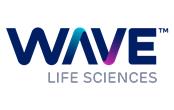
| | • | | Most WVE-003-treated participants had neurofilament light protein (NfL) levels that were in the range of placebo or had NfL levels that increased and returned to the range of placebo. |
| | • | | At 24 weeks (the last MRI assessment), mHTT reduction was correlated with slowing of caudate atrophy (R=-0.50; p=0.047). Caudate atrophy is an imaging biomarker that is predictive of clinical outcomes, including clinically meaningful worsening of Total Motor Score (TMS). |
| | • | | While not powered for clinical outcomes, a slowing of decline was observed for TMS for WVE-003 versus placebo (4.25 mean difference at 24 weeks, p=not significant). |
“We are very proud to have demonstrated mHTT lowering of 46%, with preservation of wtHTT, and are encouraged to see these reductions in mHTT significantly correlating with a slowing in caudate atrophy after just 28 weeks. These results represent a significant achievement for Wave, for the oligonucleotide field, and most importantly, for the HD community,” said Anne-Marie Li-Kwai-Cheung, MChem, MTOPRA, RAPS, Chief Development Officer at Wave Life Sciences. “Alongside the HD community, we have been working diligently to establish caudate volume as a biomarker for clinical development due to its association with clinical outcomes. We believe these strong data compel a case for accelerated approval for WVE-003, which we plan to discuss with regulators. We would like to express our immense gratitude to the HD community, the study participants, their families, and study site staff for their trust, support, and engagement that have helped us reach this important milestone.”
“Wild-type huntingtin plays such a critical role in the central nervous system, and it’s very exciting to finally have an opportunity to evaluate mHTT lowering in the context of allele-selectivity and to see positive signals emerging,” said Ralf Reilmann, MD, founder of the George-Huntington Institute, Muenster, Germany, as well as the Primary Investigator and member of the Advisory Committee for SELECT-HD. “Additionally, these data have arrived at an opportune time when the HD community is coalescing around rapid, efficient registrational trial design utilizing sensitive clinical endpoints to detect early treatment effects, and Wave is well positioned to take advantage of this momentum with WVE-003. These data provide hope and a compelling path forward as the community continues to drive toward a long-awaited therapy to treat this devastating disease.”
HD is a debilitating and ultimately fatal autosomal dominant neurological disorder. The HD population is significant – in the United States alone, approximately 30,000 people have clinical symptoms of HD and more than 200,000 are at risk of inheriting HD. WVE-003 is expected to address approximately 40% of individuals with HD, and up to 80% of HD may be addressed in the future with other SNP-targeted candidates.
“With these results, we have delivered the first-ever clinical demonstration of allele-selective silencing in any disease target. This was only possible due to the specificity, potency and durability enabled through our PRISM platform and it is validating of more than 10 years of chemistry innovation pioneered at Wave, including PN chemistry and stereochemistry,” said Paul Bolno, MD, MBA, President and Chief Executive Officer at Wave Life Sciences. “The translation of genetic insights and preclinical data in the clinic is also highly encouraging and reinforces the broader value of our pipeline. We are looking forward to our Duchenne muscular dystrophy and Alpha-1 antitrypsin deficiency data this year, the continued advancement of our INHBE program for obesity, and new targets to be shared at R&D Day this Fall, which together will open up a substantial total addressable market for Wave. We are at a very exciting point in Wave’s history as we advance our mission to unlock the broad potential of RNA medicines.”
